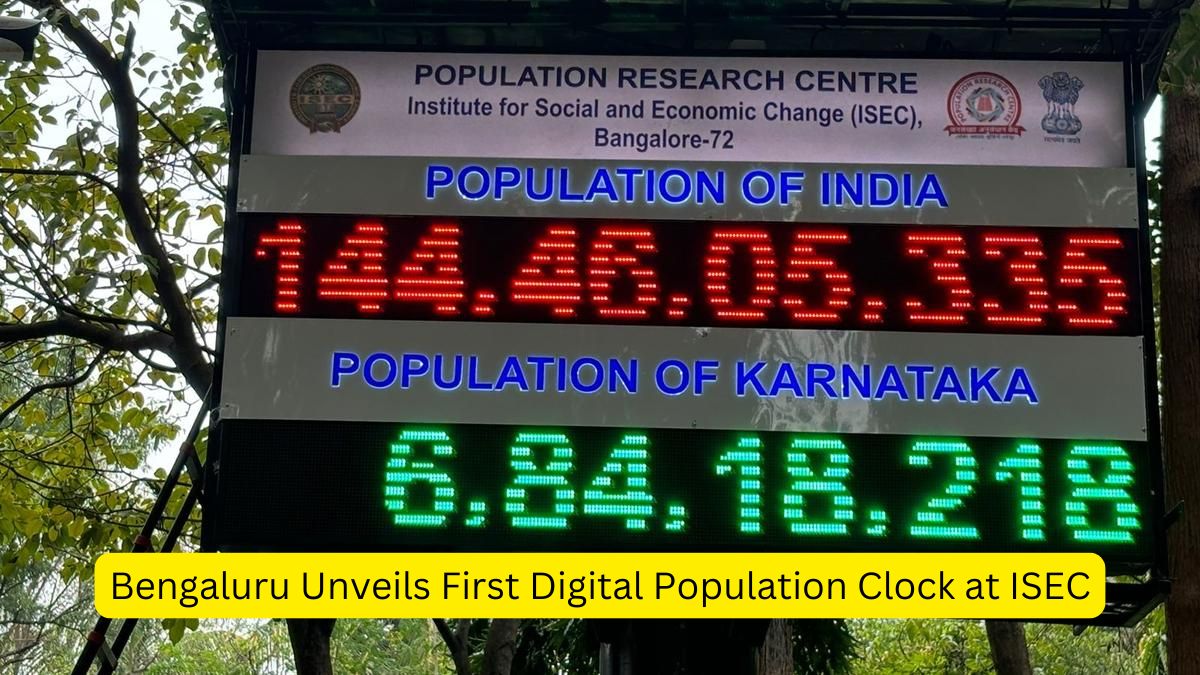On Friday, November 8, Bengaluru marked a milestone with the inauguration of its first digital population clock at the Institute for Social and Economic Change (ISEC). This innovative installation will display real-time population estimates for both Karnataka and the entire country, providing citizens, researchers, and policymakers with up-to-date demographic data.
Key Features of the Population Clock
Strategic Placement
- Positioned at the entrance of ISEC to engage and inform the public on India’s rapid population growth.
Real-Time Updates
Provides continuous updates,
- Karnataka’s Population: Refreshes every 1 minute and 10 seconds.
- India’s Population : Updates every 2 seconds.
Demographic Data Calculation
Incorporates key demographic indicators, including,
- Birth and death rates
- Migration patterns
- Life expectancy, fertility, and mortality rates
Global vs. National Clocks
- This clock is country-specific, focusing on national and state-level data, unlike global population clocks that track worldwide population trends.
Project Collaboration and Objectives
Collaborating Bodies
- Jointly developed by ISEC and the Union Ministry of Health and Family Welfare (MoHFW).
National Project
- Part of a broader MoHFW initiative to install population clocks at 18 Population Research Centres (PRCs) across India.
Primary Objectives
- Increase public awareness of population growth’s impact on sustainable development.
- Provide accurate, up-to-date data for research on demographic trends.
- Support researchers and policymakers in understanding population dynamics.
Census Data Research Workstation at ISEC
Purpose
- Offers researchers and students access to comprehensive census data to facilitate demographic studies.
Capabilities
- Equipped with advanced software and analytical tools for in-depth population analysis.
- Supports detailed examinations of population trends to aid policy and development planning.
About Population Research Centres (PRCs)
Establishment
- Created by the Ministry of Health and Family Welfare, Government of India.
Mandate
- Conduct research and provide insights to support Health and Family Welfare Programs and Policies.
Research Focus
- Family planning and demographic trends
- Biological and qualitative studies on population control
Research Objectives
- Understand population dynamics.
- Evaluate family planning program effectiveness.
- Identify key factors influencing fertility and mortality rates.
- Develop recommendations to inform policy and program implementation.
Activities and Contributions of PRCs
Research Activities
- Conduct original studies on population and health.
- Analyze demographic data and existing literature.
- Publish and present research findings.
- Collaborate with researchers and institutions in relevant fields.
Technical Support
- Provide expertise to government agencies and NGOs.
Network
- Comprises 18 PRCs nationwide, based in universities and research institutes.
Contributions to Policy and Program Development
- Policy and Program Support: PRCs play a critical role in shaping family welfare and health policies.
- Evidence-Based Research: Strengthen the foundation for effective population and health interventions.
- Capacity Building: Enhance the skills and capabilities in population research and analysis across India.
| Summary/Static | Details |
| Why in the news? | November 8, Bengaluru marked a milestone with the inauguration of its first digital population clock at the Institute for Social and Economic Change (ISEC). |
| Function | Displays real-time population estimates for Karnataka and India |
| Real-Time Updates | Karnataka population updates every 1 minute, 10 seconds
– National population updates every 2 seconds |
| Demographic Data Sources | – Birth and death rates
– Migration patterns – Life expectancy, fertility, and mortality rates |
| Objective of the Clock | Raise public awareness on population growth and its impact on sustainable development |
| Project Collaboration | Joint initiative by ISEC and the Union Ministry of Health and Family Welfare (MoHFW) |
| Additional Facility | Census Data Research Workstation at ISEC, providing access to census data for research and policy planning |
| Population Research Centres (PRCs) | – Established by MoHFW
– Focus on demographic research, family planning, and population control |
| PRCs’ Research Objectives | – Study population trends and dynamics
– Evaluate family planning programs – Develop evidence-based recommendations |
| PRCs’ Activities | – Conduct original studies
– Analyze data – Publish findings – Collaborate with researchers – Provide technical assistance to agencies and NGOs |
| Significance | Supports researchers, scholars, and policymakers with valuable demographic data and strengthens evidence-based decision-making for population health programs |




 Cabinet Nod to Atomic Energy Bill Unlock...
Cabinet Nod to Atomic Energy Bill Unlock...
 Insurance Amendment Bill 2025: Cabinet A...
Insurance Amendment Bill 2025: Cabinet A...
 Government to Rename MGNREGA, Hikes Job ...
Government to Rename MGNREGA, Hikes Job ...







